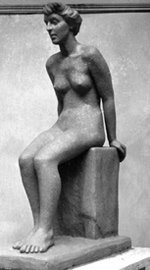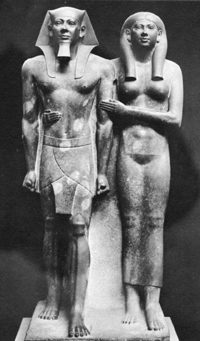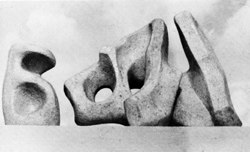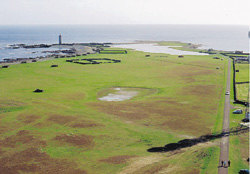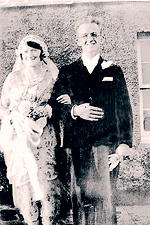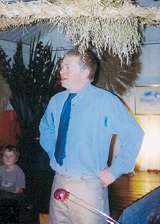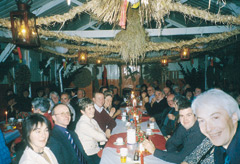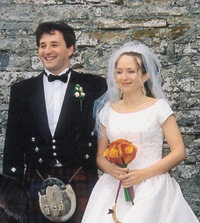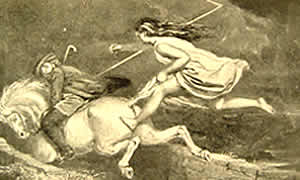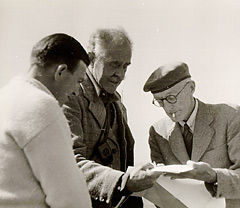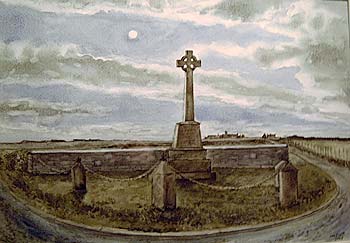It’s a while since last I wrote, so here goes for another letter.
This is the month of May when the weather should be looking and feeling like summer.
Instead, on the 17th of the month, large flakes of snow came swirling, heavily, albeit briefly, out of the north and whitened the ground for a time. Imagine that! Almost unbelievable, you might think at this time of year.
What is also as unbelievable (to some of us at least) is that five islanders, of whom I am the only one living on the island, who went to school together (1945-1952) can now say that we have all become OAPs – the two ladies of our school class have, of course, been in that category since they turned 60.
Anyhow, when we and our contemporaries were younger and heard of this person and that person reaching pension age, we generally thought: “Weel, the’ir juist gottin tae be aald fok.”
On the other hand, at least the bluebells are in bloom and the old fashioned lily (narcissus) has appeared lately.
I look forward every year to their arrival, and always have a few in the house. The scent of these flowers pervades the room, and their elegant form is a pleasure to the eye.
As to being OAPs, I’m always reminded, as I’ve mentioned before, of the old Chinese poet, 2000 years ago, who wrote a poem on being 60.
He said that he was far from old age and being decrepit, and that between 60 and 70 he could still seek the rivers and hills. Let us hope firstly, that the weather improves and that secondly, OAPs can be like the Chinese poet – even beyond the 70 mark.
A few days ago, when we were enjoying a brief spell of fine weather, the moon could be seen during the day in the east. She appeared like a ghost in the blue sky. It seems very strange to actually see the moon when the sun is shining, but there she was.
Two days ago she was full, and at night looked magnificent, but last night she swam in a watery sky and tonight her silvery light is hidden behind a canopy of cloud. The wind is a cold southeasterly, and grey, sullen mist that came down in the mirking has turned into rain and I can hear the pitter patter on the roof. In fact it’s not at all pleasant and the mournful sound of the foghorn comes and goes.
The only consolation is the calling of the birds: In particular the whistling of the ‘whap’ but I can also hear the ‘sheldars’ in the background and the easterly wind carries the tang and sound of the sea
Speaking about birds – when I was out in the fields recently doing a bit of rolling, I saw three young lapwings or, as we say, ‘tee-wups’. They were running as fast as their legs could carry them, first one way then another.
All the while their parents flew above, sometimes landing, but decidedly guiding their family from the air away from mortals such as myself.
And then in the barn, for days, I had been aware of a little wren flying out through the open door as I went through.
On closer investigation I discovered a nest, most beautifully made, cup-shaped with the smallest entrance hole. At night I had a better look with a flashlight – away flew Jenny Wren, but I knew she would be back. On tiptoe, I could see four tiny, whitish coloured eggs, and the inside of the nest, which had been woven of hay, was lined neatly with white feathers.
Her nest had been made in the coils of an old sisal creel rope from the 60s.
For some 40 years or so the old rope had hung untouched. Once it had helped to catch a lobster or two, now it was being put to use to bring a family of wrens into the world to entertain us with their musical song.
This is another day and, after a night of heavy rain – 11.9mm, John Cutt tells me – the wind has swept strongly into the southwest. The sun has been bright all day and the west sea is fairly dancing.
As the evening began to close-in, the wind moderated a little, but into the north it seems to be heading. Grey and pink-tinged cloud began to fill the sky and away on the horizon the yellow and orange of a mostly hidden sunset appeared above the cold, steel blue of the sea. If this weather continues, silage, hay and grass will certainly not be very abundant this season.
Island news I’ll cover briefly as well as I can remember – my diary is a help. After the school’s open day at Easter, the North Ronaldsay Trust held a spring fayre when many and varied items were for sale, with numerous attractive and valuable prizes kindly donated for the raffle.
Two members of Friends of the North Ronaldsay Trust travelled from the Mainland to help. A sum in excess of £400 was raised.
Otherwise, the community association ran a series of evening classes, in yoga and computing, ending in March, and a whist drive raised around £70 for the association; while, at the bird observatory, a most enjoyable informal get-together took place, when a number of very competent musicians from the Mainland performed over a weekend stay.
On the two evenings a good company of islanders and visitors enjoyed the music and song.
Two talks at the community centre took place relatively recently and were well attended. First was John Mowat who gave an illustrated lecture on the Faroe islands – updating a previous one (Aberdeen University sponsored lectures), and a little later Jenny Taylor (Orkney Woodland Development Project) gave useful and expert advice on treeplanting – a difficult business requiring knowledge on soil suitability, initial protection, and the most likely type of tree to survive Orkney’s exposed geographical situation.
Island work such as native sheep punding, ploughing, artificial fertilizer sowing, rolling etc has more or less followed the usual season’s pattern. Barley has now, I believe, all been sown. Sadly perhaps, after, I suppose, hundreds of years, not a peat has been turned at Antabreck.
No oats sown for the first time in my memory at this house – the hairst time will never be the same.
Well folks, this is not going to be too long a letter. For the moment I think I’ll go to bed before the ‘heuld o’ the night’ which is fast approaching – I’m going though, to read a bit more of Walter Traill Dennison’s book, The Orcadian Sketch-Book (published in 1880), a copy of which I have on loan.
While on a visit recently I came across this book and in it I saw Denninson’s classic story, The Heuld-Horn Rumpis – a tale which I have been long wanting to read. It is written (as all the stories in the book are) in the dialect of the writer’s native isle of Sanday.
Dennison says: “The author’s principal object has been to preserve the dialect of his native islands . . .”
The heuld is explained as midnight, and the heuld horn was a kindly old custom of Norse origin where sometime after the guests had retired to bed, the lady of the house would make a round of the bedrooms offering every guest a drink of warm spirituous liquor.
This was, Dennison says, the “heuld-drink” which was presented in a small horn vessel called the “heuld horn”.
I can tell you that, in this particular story, the heuld horn offered to the guests and the copious refreshment before certainly led to a proper ‘rumpis’ – at one point in the narrative a minister, who had sensibly retired to bed was offered the “heuld-drink” by the formidable lady of the house.
Being a widow twice over, she had other designs on her guest who was fortunate to escape through the window but with only part of his bed-gown remaining.
Another day and the wind is in the north and forecast to veer into the northeast with more rain on the way.
The morning brought ‘flams o’ weet,’ but as I draw this letter to a close, the sun has just appeared, veiled behind thin cloud. Nevertheless, the air has warmed a little.
I’ve just had a phone call to tell me that there is a three-masted sailing ship passing to the north. She is a fine sight as she sails swiftly east with the flood and a following wind. Her white sails (some furled) stand out against a dull sky of pale blue and passing, purple tinted cloud. Her hull is painted red.
I imagine she is about halfway between the island and the Fair Isle which I can just see behind the ship – today there is a bit of haze in the distance giving the isles a pale blue, faraway appearance.
This is indeed a sight from the past and conjures up memories of the great days of sail one reads about; flying down the Roaring Forties or scudding along with the trade winds or fighting a perilous passage round Cape Horn.
A verse from John Masefield’s poem Sea-Fever should round off this letter nicely.
I must go down to the sea again, for the call of the running tide
Is a wild call and a clear call that may not be denied;
And all I ask is a windy day with the white clouds flying,
And the flung spray and the blown spume, and the sea-gulls crying.

